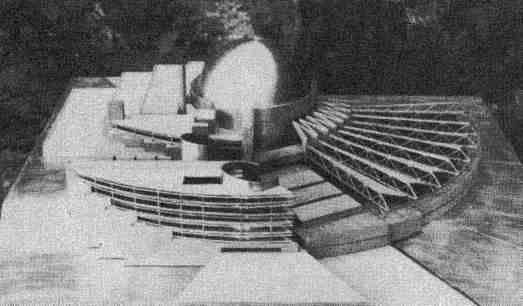


Notice
Advanced Neutron Source
 Architectural model of new Advanced Neutron Source at Oak Ridge. (USA)
Architectural model of new Advanced Neutron Source at Oak Ridge. (USA)
Over the past two decades, a considerable erosion in the strength of the US neutron capability has occurred relative to other industrialized countries. The Department of Energy of the United States has requested $40,000,000 for the Advanced Neutron Source (ANS), an increase of $23,000,000 or 135%, over the FY 1994 appropriation of $17,000,000. A report on the Advanced Neutron Source (ANS) Project at the Oak Ridge National Laboratory made up the March 1993 issue of the ANS News Source. The eight page publication outlines the conceptual design, participants, project scope, cost estimate, features of the projected user facility, containment design, and details of the design of the optical filters. The scientific facilities and goals for the facility are described in Table 1. Materials analysis facilities will include: prompt gamma analysis (two horizontal guide stations); neutron depth profiling (two slant guide stations); neutron activation analysis (two laboratories with office space and a shielded transfer area); pneumatic rabbit tube facilities (five in reflector plus two in the light water pool). Materials radiation support facilities will include: hot cells, control room, shielded valve box, assembly, and handling space; gamma irradiation facility.
Table 1. The ANS Project
| Thermal neutron flux (unperturbed), m-2·s-1 | 7.5 × 1019 |
| Power, MW(th) | 300 |
| Horizontal beams | |
|---|---|
| Very cold | 2 |
| Cold | 14 |
| Thermal | 8 |
| Hot | 2 |
| Slant beams | |
| Cold | 2 |
| Thermal | 1 |
| Hot | 0 |
| Number of beam experiments | 48 |
| Number of scientists | 240 |
| Material analysis facilities | yes |
| Materials irradiation support facilities | yes |
| Positron source | yes |
The design of the complex keeps the two distinctly different functions of research and reactor operations physically separate, while maintaining the link between them through a common entry point into the complex. The buildings have been located in a way that places the foundations of the reactor and reactor support buildings on sound bedrock and provides a stable foundation for the guide hall. The lobby area, the visitors' gallery, where visitors can observe experiments in progress and other related exhibits, and the office building fall into the lowest security level. The research support building, which contains shops and laboratories dedicated to research activities, and the guide hall are located within the next higher level of security control. The beam room in the reactor building, although open to researchers, requires more stringent security measures.
Taken from ANS News Source, March 1993

